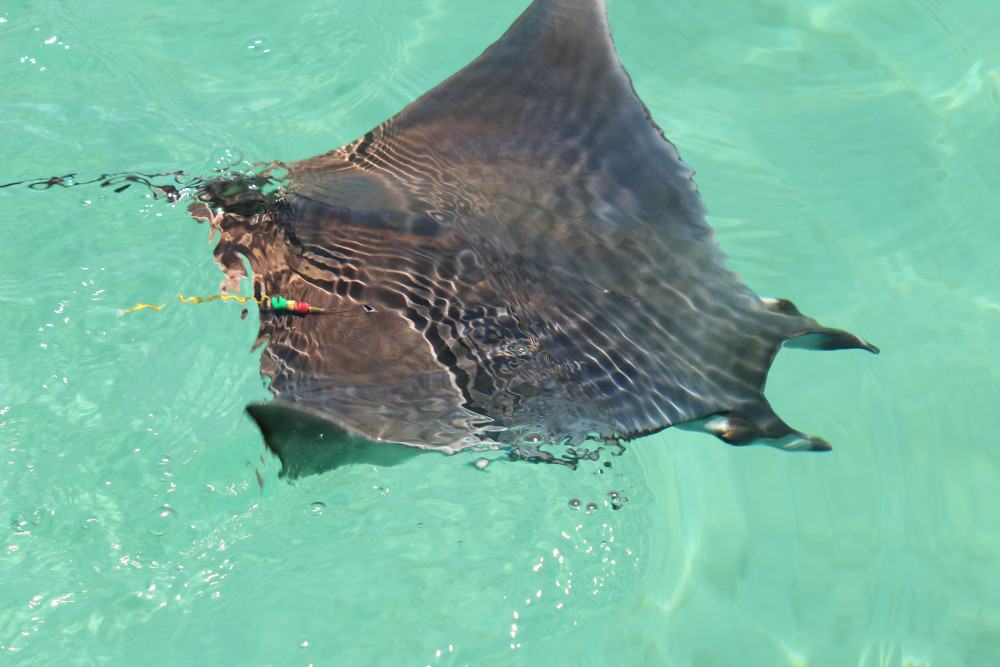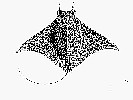Mobula munkiana
Notarbartolo Di Sciara, 1987
Munk's devil ray
Classification: Elasmobranchii Myliobatiformes Mobulidae
Reference of the original description
A revisionary study of the genus Mobula Rafinesque, 1810 (Chondrichthyes: Mobulidae), with the description of a new species. Zoological Journal of the Linnean Society, 91(1), 1–91
A revisionary study of the genus Mobula Rafinesque, 1810 (Chondrichthyes: Mobulidae), with the description of a new species. Zoological Journal of the Linnean Society, 91(1), 1–91
Image of the original description
Image in copyright.
Image in copyright.
Synonyms / new combinations and misspellings
Mobula cf. munkiana
Mobula cf. munkiana
Types
Mobula munkiana
Holotype: SIO: 84-29; Paratype: SIO: 85-34; SIO: 53-178-6A; SIO: 84-29; SIO: 85-35;
Mobula munkiana
Holotype: SIO: 84-29; Paratype: SIO: 85-34; SIO: 53-178-6A; SIO: 84-29; SIO: 85-35;
Description :
Citation: Mobula munkiana Notarbartolo Di Sciara, 1987: In: Database of modern sharks, rays and chimaeras, www.shark-references.com, World Wide Web electronic publication, Version 12/2025
Please send your images of "Mobula munkiana" to info@shark-references.com

Mobula munkiana Notarbartolo Di Sciara, 1987 © Marta D. Palacios, Mexico

Mobula munkiana Notarbartolo Di Sciara, 1987 © Marta D. Palacios, Mexico
Common names
 Diabolo manta,
Diabolo manta,  Manta chica,
Manta chica,  Manta de Munk,
Manta de Munk,  Manta violácea,
Manta violácea,  Mante de Munk,
Mante de Munk,  Munk"s devil ray,
Munk"s devil ray,  Pygmy devil ray,
Pygmy devil ray,  Smoothtail mobula
Smoothtail mobula
 Diabolo manta,
Diabolo manta,  Manta chica,
Manta chica,  Manta de Munk,
Manta de Munk,  Manta violácea,
Manta violácea,  Mante de Munk,
Mante de Munk,  Munk"s devil ray,
Munk"s devil ray,  Pygmy devil ray,
Pygmy devil ray,  Smoothtail mobula
Smoothtail mobula
Distribution
Eastern Pacific: Gulf of California, Ecuador, and the Galapagos Islands. Source: www.gbif.org
Eastern Pacific: Gulf of California, Ecuador, and the Galapagos Islands. Source: www.gbif.org
Human uses
fisheries: commercial
fisheries: commercial
Biology
Exhibit ovoviparity (aplacental viviparity), with embryos feeding initially on yolk, then receiving additional nourishment from the mother by indirect absorption of uterine fluid enriched with mucus, fat or protein through specialised structures [733]. Pelagic species forming schools in coastal and oceanic waters, but also found near the bottom. Found singly, in small groups, or in schools [1658]. Feeds mainly on planktonic crustaceans, but also takes small schooling fishes.
Exhibit ovoviparity (aplacental viviparity), with embryos feeding initially on yolk, then receiving additional nourishment from the mother by indirect absorption of uterine fluid enriched with mucus, fat or protein through specialised structures [733]. Pelagic species forming schools in coastal and oceanic waters, but also found near the bottom. Found singly, in small groups, or in schools [1658]. Feeds mainly on planktonic crustaceans, but also takes small schooling fishes.
Remarks
shark-references Species-ID=3757; CITES: (see: Protected Species for more details) Convention on International Trade in Endangered Speciesof Wild Fauna and Flora annex: II; Council Regulation 2017/160 annex: B
shark-references Species-ID=3757; CITES: (see: Protected Species for more details) Convention on International Trade in Endangered Speciesof Wild Fauna and Flora annex: II; Council Regulation 2017/160 annex: B
Parasites (arranged by Jürgen Pollerspöck)
Cestoda
Trematoda
Cestoda
- Hemionchos mobulae Campbell & Beveridge, 2006 [9451] [23771]
- Parachristianella dollfusi Schaeffner & Marques, 2018 [26286]
- Parachristianella trygonis Dollfus, 1946 [21205] [23771]
Trematoda
- Anaporrhutum euzeti Curran, Blend & Overstreet, 2003 [23771]

















